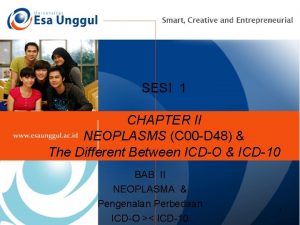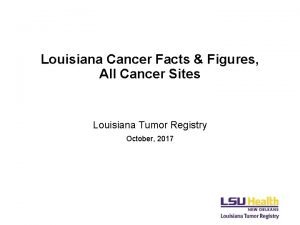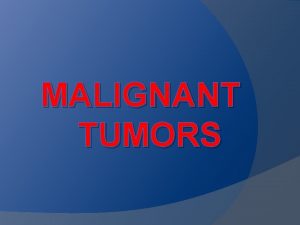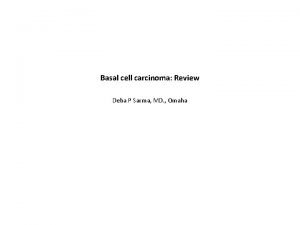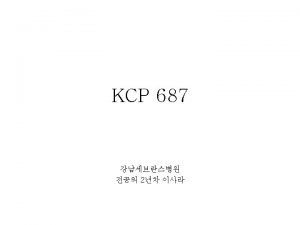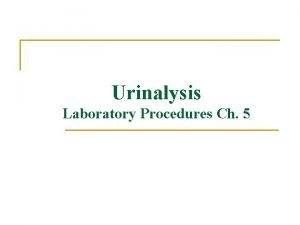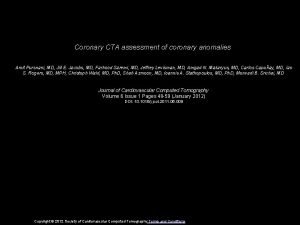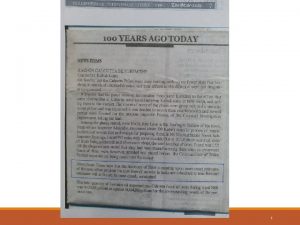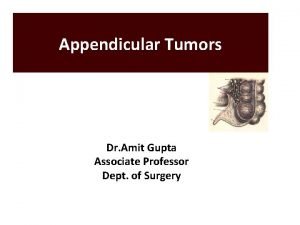Renal Cell Carcinoma Dr Amit Gupta Associate Professor




















- Slides: 20

Renal Cell Carcinoma Dr. Amit Gupta Associate Professor Dept. of Surgery

Epidemiology • Male predominance (M: F 1. 5: 1). • Most common in sixth to eighth decades; peak incidence in sixth decade • Metastatic disease in 30% at diagnosis, and eventually in 50% (lung, liver, bone, distant LN, adrenal, brain, opposite kidney, soft tissue) • Most sporadic RCCs are unilateral and unifocal

• Stage at diagnosis is the most important prognostic factor • Predominant histologic type: adenocarcinoma arising from tubular epithelium • Adenocarcinoma subtypes: – clear cell (75– 85%) – chromophilic/ papillary (10– 15%) – chromophobe (5– 10%) – oncocytic (rare) – Sarcomatoid (1– 6%; poor prognosis)

Papillary (chromophilic) renal cell carcinoma extending into the collecting system

Risk factors • Tobacco , urban environmental toxins (cadmium/ asbestos/ petrols), obesity, high dietary fat intake, acquired cystic renal disease from renal failure • Association with von Hippel-Lindau disease: – autosomal dominant – loss of 3 p – >70% chance developing RCC (almost all clear cell histology) risk of developing multiple other benign and malignant tumors (retinal angiomas, CNS hemangioblastomas, pheochromocytoma , pancreatic cancer)

Pathology • Round to ovoid • Circumscribed by a pseudo capsule of compressed parenchyma and fibrous tissue • Nuclear features can be highly variable

Diagnosis • Common signs and symptoms: – – – hematuria (80%) flank pain (45%) flank mass (15%) classic triad of prior three only present in 10% normocytic/normochromic anemia, fever, weight loss • Less common signs and symptoms: – hepatic dysfunction without mets – Polycythemia – hypercalcemia (occurs in 25% of patients with RCC mets)

Paraneoplastic syndromes in 20% of patients with RCC

Diagnosis • Labs: CBC, LFT, BUN/Cr, LDH, urinalysis • Imaging: – CT abdomen – MRI abdomen if CT suggests IVC involvement • Metastatic evaluation: – Chest X ray – Bone scan or MRI brain only if clinically indicated

CT scan shows right renal tumor with perinephric stranding suggesting invasion of the perinephric fat

Contrast inferior venacavogram in patient with a right renal tumor shows involvement of the subdiaphragmatic vena cava

• PET: equivocal findings on conventional imaging • Percutaneous renal biopsy or aspiration: limited role

Staging AJCC 7 th Edition



Prognostic Factors For RCC

Management Stage I-III Nephrectomy • Open radical nephrectomy, but laparoscopic gaining popularity • Nephron sparing surgery via partial nephrectomy, if possible (open or laparoscopic) • Possible to spare adrenal gland in ~75% cases No role for adjuvant chemo/immunotherapy

No widely accepted role for neoadjuvant or adjuvant radiotherapy. Retrospective data suggest possible utility in select cases: – Positive surgical margins – Locally advanced disease with perinephric fat invasion and adrenal invasion (IVC/renal vein extension alone does not increase local recurrence significantly) – LN+ – Unresectable (pre-op RT)

Stage IV Cytoreductive nephrectomy: improved survival with nephrectomy followed by interferon alpha vs. interferon alpha alone

Systemic therapy • Immunotherapy (IL-2, interferon alpha, or combination) • High dose IL-2 only FDA approved treatment for • Biologic agents show promise in recent trials • Bevacizumab • Sorafenib or sunitinib • Temsirolimus Consider chemo (gemcitabine ± 5 -FU or capecitabine) Focal palliation of metastases • RT alone • Metastasectomy • Combination of both
 Res extra commercium
Res extra commercium Diagnostico etiologico
Diagnostico etiologico Renal cell carcinoma
Renal cell carcinoma Promotion from assistant to associate professor
Promotion from assistant to associate professor Amit gupta microsoft
Amit gupta microsoft Carcinoma renal de células claras fuhrman
Carcinoma renal de células claras fuhrman Cortical and juxtamedullary nephrons difference
Cortical and juxtamedullary nephrons difference Kode icd 10 oat
Kode icd 10 oat Squamous cell carcinoma louisiana
Squamous cell carcinoma louisiana Basal cell carcinoma
Basal cell carcinoma Squamous cell carcinoma
Squamous cell carcinoma Non neoplastic epithelial disorders
Non neoplastic epithelial disorders Basal cell carcinoma
Basal cell carcinoma Hedgehog urchin
Hedgehog urchin Anaplastic squamous cell carcinoma
Anaplastic squamous cell carcinoma Epithelial cells in urine images
Epithelial cells in urine images Amit somech
Amit somech Amit somech
Amit somech Dr amit pursnani
Dr amit pursnani Amit dio egizio
Amit dio egizio Amit garg irse
Amit garg irse







